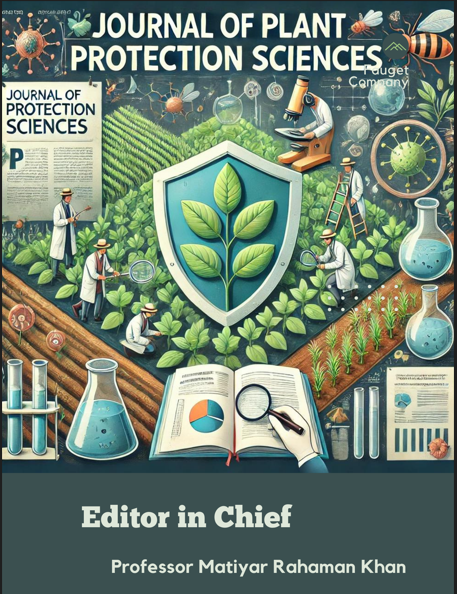Morphological changes of different castes of the subterranean termites (Odontotermes proformosanus) in fungus combs of termitophiles
DOI:
https://doi.org/10.48165/Keywords:
Fungus comb, Odontotermes proformosanus, morphological changes, nymphs, termitophilesAbstract
Termitidae is the largest family of termites. The workers of the subfamily Macrotermitinae have the extra-ordinary phenomena of making fungus combs inside the termitophiles. Considering the consistency of fungus-bed in the termitophiles, an attempt has been made to observe the morphological changes of nymphs while they stayed within the fungus comb. Biological attributes indicated that Odontotermes proformosanus are polymorphic in nature and have exopterygote post-metamorphic development. During the period of study, eggs and nymphs were collected in different seasons from the fungus combs of termite mounds. Eggs of O. proformosanus were found profusely in fungus comb in the months of March, May, September and October of 2006 to 2008 Average lengths and standard deviation (mean±SD) of the eggs were (0.66 ± 0.09), width (0.04 ± 0.07) mm and egg shape ratio is 0.53. Eggs were mostly of broad type. st th st Distinct quiescent period was also observed. Morphological changes completed within 1 to 5 stages. In the 1 stage, th total length ranged from 0.8-1.5 mm. Terminal form of workers and soldiers were attained at the 5 stage (4.1- 4.5 mm in body length). During the period of observation, it was found that total length of the nymph, head length and head capsule width are significantly correlated at 0.01 level in their five different development stages.
References
Abo-Khatwa, N. (1978). Cellulase of fungus-growing termites: A new hypothesis on its origin. Experientia, 34(5), 559-560.
Fernando, H.K. (1960). Termites of economic importance in Ceylon. In Termites in the Humid Tropics, Proceedings of New Delhi Symposium, UNESCO, pp. 205-209.
Grassé, P.P. (1937). Recherches sur la systématique et la biologie des termites de l'Afrique occidentale française. Annales de la Société Entomologique de France, 106, 1-100.
Grassé, P.P. (1949). Ordre des isoptères ou termites. In Traité de Zoologie (Ed. Grasse, P.P.), Paris, Masson, Insectes, 9, 408-544.
Hickin, N.E. (1971). The biology of termites. In Termites: A World Problem, Hutchinson, London, UK, pp. 100-113.
Hill, G.F. (1925). Notes on Mastotermes darwiniensis Froggatt (Isoptera). Proceedings of the Royal Society of Victoria, 37, 119-124.
Hopkins, J.D. (2003). Subterranean Termite Identification and Biology. University of Arkansas, Division of Agriculture Cooperative Extension Services, pp. 7.
Howard, R.W. & Haverty, M.I. (1980). Reproductives in mature colonies of Reticulitermes flavipes: abundance, sex ratio, and association with soldiers. Environmental Entomology, 9, 458-460.
Imms, A.D. (1957). Isoptera. In A General Textbook of Entomology, (Eds. Richards, C.W. & Davies, R.G.), Methuen and Co. Ltd., London, UK, pp. 366-395.
Krishna, K. & Weesner, F.M. (1970). Biology of Termites, Vols. I & II. Academic Press, New York and London, pp. 643.
Krishna, K. (1989). Order: Isoptera. In An Introduction to the Study of Insects, (Eds. Borror, D. & Triflehorn, C.A. & Johnson, N.F.), Saunders College Publishing, Philadelphia, USA, pp. 234-241.
Lee, K.E. & Wood, T.G. (1971). Termites and Soils. Academic Press, London and New York, pp. 251.
Light, S.F. & Weesner, F.M. (1955). The production and replacement of soldiers in incipient colonies of Reticulitermes hesperus Banks. Insectes Sociaux, 2, 347-354.
Luscher, M. (1951). Significance of fungus garden in termite nests. Nature, 167, 34-35.
Noirot, C. & Noirot-Timothéé, C. (1969). The digestive system. In Biology of Termites (Eds. Krishna, K. & Weesner, F.M.), Vol. 1. Academic Press, New York, USA, pp. 49-88.
Roonwal, M.L. (1975). On a new phylogenetically significant ratio (Width/Length) in termite eggs (Isoptera). Zoologischer Anzeiger, 195(1-2), 43-50.
Roonwal, M.L. & Chhotani, O.B. (1989). The Fauna of India and the Adjacent Countries: Isoptera (Termites). Zoological Survey of India, 1, 81-85.
Snyder, T.E. (1913). Changes during quiescent stages in the metamorphoses of termites. Science, 38, 487-488.
Weesner, F.M. (1960). Evolution and biology of termites. Annual Review of Entomology, 5, 153-170.
Wood, T.G. & Sands, W.A. (1978). The role of termites in ecosystems. In Production Ecology of Ants and Termites (Ed. Brain, M.V.), Cambridge University Press, UK, pp. 245-292.
Wood, T.G. & Pearce, M.J. (1991). Termites in Africa: The environmental impact of control measures and damage to crops, trees, rangeland, and rural buildings. Sociobiology, 19, 221-234.
Weyer, F. (1935). Epithelneuerung im Mitteldarm der Termiten während der Hautung. Zoomorphology, 30, 648-672.

